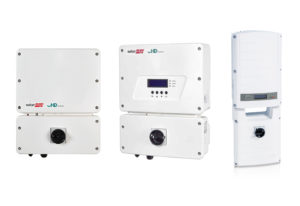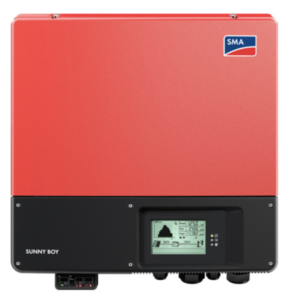

Need some help?
We understand that going solar is a new thing for most people. And while we answered lots of questions during the installation process, we certainly don’t expect you to be a solar expert. Leave that to us, your Customer Support team!
Our COVID-19 Response
We’re adjusting our business operations in light of COVID-19 safety protocols. If you need assistance with your solar loan payments, check out our COVID-19 response page and learn about the programs our financial partners have in place to help you out. Our Customer Support Team continues to operate at a limited capacity. Our response time will be longer than usual and we appreciate your patience as we work to support you and others.
Having trouble with your solar equipment?
Take a look at some of the resources we’ve collected below. If those don’t help, please send us an email or use the “Contact Us” chat in the bottom right corner of your screen to submit a case to our team.
Inverters
Inverters take the DC current that solar panels produce and invert it to AC current making the power usable in your home and on the grid. The types of inverters currently and previously installed by SunCommon are: SolarEdge, Fronius, SMA, and Aurora PV1 (Power One). The latter three inverters may be branded by SunPower.
Learn More About Your Inverter
Monitoring
SunCommon does not actively monitor your solar system. So, we want to make sure you understand the tools available to help you catch any potential errors. We recommend checking on your system at least twice a month to be sure it’s operating properly. You can do this by looking at your inverter, or, for some of you, by logging into your online monitoring or electric utility account.
Online monitoring allows you to see via your phone or computer how much energy your solar is producing. The pages in this section will go through the types of online monitoring systems used and some typical troubleshooting techniques.
If you have green lights on your inverter and no error messages, then you know your system is operating just fine and it is the reporting software that has lost its connection.
Learn more about your Monitoring
FAQs
The short answer is no. We’d prefer you don’t climb on your roof to wrestle snow off your panels or use a rake to pull a load of snow down on top of you. The panels are dark and will soon gather enough sun to melt the snow which will slide off the slick glass surface. Swinging a rake or shovel up there could harm a panel or catch on a roof-mount. And of course the warranty doesn’t cover damage caused by the homeowner.
Things to keep in mind: We designed your system with deep winters in mind, meaning we planned for short cloudy days and snow coverage. Don’t worry; you’ll make up for it in the summer!
If you would like to learn more about snow on solar panels You can find information in our full length article Snow on Solar Panels.
You’ll need to fill out IRS form 5695.
Read our FAQ on how to claim your Solar Investment Tax Credit (ITC).
Solar doesn’t work at night. But that’s okay! At night your solar panels and inverter power down. The inverter isn’t running overnight because it doesn’t want to draw power. Instead it’ll wake back up when the sun shines in the morning.
Your home and solar system are connected to the utility grid. On long, sunny days, your solar panels pour power past the meter – running it backwards – racking up credits on your utility bill. You draw down those credits overnight or during the darker, winter months. This is all thanks to a process called net-metering. It’s that simple.
Solar panels do produce better at cooler temperatures! Hot, hot heat is hard on electronics in the summer, so the cooler days and months provide more efficient solar production. So, those hot blue sky summer days? Your solar system will be cranking, but you won’t see it performing at its max power level.
Learn more in our full length article How do the seasons and weather affect my solar production?
If you have Home Energy Storage, like the Tesla Powerwall, please review our Powerwall FAQs for more details.
—
Unless you have Home Energy Storage, solar doesn’t produce energy when the power is out. If your power goes out, contact your utility company to be sure they are aware of the outage.
Once the power is back on, there are a few steps you can take to check the system and make sure it’s all working as usual:
- You may need to reset your internet connection to re-establish monitoring communication – just unplug your router for about 5 minutes, then plug it back in. It can take your monitoring a day or so to come back online.
- Take a look at your inverter. If the display looks normal, great! Your system is working properly and producing clean solar energy. If there’s an error code, simply reset the inverter by following these steps:
- Turn off the DC disconnect on your inverter. This is the black dial on the front or bottom of the inverter. Simply turn it to the “off” position.
- Turn off your system’s AC disconnect. This is located outside next to your utility meter and is just a lever that you’ll pull down into the “off” position.
- Wait five minutes, then turn them back on in reverse order. Throw the AC lever back up into the “on” position, then turn the dial on the inverter back to the “on” position to bring the DC back online.
The inverter will start to turn back on and may take a minute or two to reboot. You should see the main screen as normal once the reboot is complete with no error message.
If you take these steps and still aren’t seeing information about your system on the inverter, please give us a call at 802-882-8685.
We offer de-installation and re-installation of solar equipment to accommodate roofing work! Our Customer Support team would be happy to work with you to put together a custom quote and understand the project scope and timeline. Please get in touch with us using the contact information at the bottom of this page.
Inverters
Inverters take the DC current that solar panels produce and invert it to AC current making the power usable in your home and on the grid. The types of inverters currently and previously installed by SunCommon are: SolarEdge, Fronius, SMA, and Aurora PV1 (Power One). The latter three inverters may be branded by SunPower.
Monitoring
SunCommon does not actively monitor your solar system. So, we want to make sure you understand the tools available to help you catch any potential errors. We recommend checking on your system at least twice a month to be sure it’s operating properly. You can do this by looking at your inverter, or, for some of you, by logging into your online monitoring or electric utility account.
Online monitoring allows you to see via your phone or computer how much energy your solar is producing. The pages in this section will go through the types of online monitoring systems used and some typical troubleshooting techniques.
If you have green lights on your inverter and no error messages, then you know your system is operating just fine and it is the reporting software that has lost its connection.
CSA Customers
Trying to make sense of your electric bill with Community Solar? Check out some of our blog posts on the subject!
Tesla Powerwall
Your Powerwall is a battery that stores energy, detects outages, and automatically becomes your home’s energy source when the grid goes down. Your solar and Powerwall work together to keep the essentials of your home running.
The Tesla mobile app is your new best friend! If you have not downloaded it yet, please do so now. You need a strong internet connection (hardwired Ethernet, your home Wi-Fi or a cellular connection) for the Powerwall to receive software updates and communicate with the Tesla app.
The Tesla app allows you to manage and monitor your Powerwall in real time, from anywhere. Click here for a Tesla mobile app overview.
From the home screen select ‘Power Flow,’ to see how your Powerwall is interacting with your home, the electric grid, and your solar system (if applicable). From the ‘Power Flow’ screen, you can also select the bar chart icon to see more detail and historical usage information.
If you own* your Powerwall, you can customize the app to meet your specific needs. In the “Customize” section of your Tesla app, you can change how your Powerwall is charged and discharged, and even fine tune how much power to reserve in the event of an outage. Please visit Tesla’s website for more details on each setting.
*Please note, if you are a part of Green Mountain Power’s BYOD or Resilient Home Lease program, you will not have as much control over your Tesla app settings.
Blinking: No data transfer to the Tesla App
Solid: Communicating
Pulsing: Discharging or charging
If you accidentally leave your Powerwall circuit breaker open (meaning your Powerwall circuit breaker is in the off position), this can prevent the Powerwall from operating. It can also cause the Powerwall to slowly deplete its power reserve, which can require service. Customers will receive an alert through their mobile app if an open breaker is detected. The app will show a link to Tesla’s Troubleshooting website section, which will then prompt you to restart the Powerwall.
When the Powerwall is in Storm Watch mode, if the National Weather Service detects a storm/emergency event, the Powerwall will be switched to Backup only and will be charged from both the solar system and the grid during the “storm event”. You can see where power is coming from (solar or grid) in Power Flow within the Tesla app. After the event, the app will be switched back to whatever mode you were in before the storm watch was triggered.
Your Powerwall is also equipped with an automatic “Preconditioning” function/feature. Anytime Tesla detects a cold weather event (55°F or below), before the event they will precondition the battery in order to heat it up and make sure it is warm enough to function and charge efficiently. The Power Flow screen may show energy flowing to the Powerwall from solar or the grid. This is normal behavior, and the energy is only being used to heat, not to charge in this scenario.
Did you make any changes to your WiFi network (i.e. new router, new network name or password)?
If you’ve made changes to your WiFi network, you may need to reconnect your Backup Gateway to your new network. Instructions can be found here.
If you did not make changes to your WiFi network, or the above instructions do not work, please call Tesla directly. SunCommon has limited access to the back-end of your Tesla app- only Tesla has the ability to see detailed information and reset the Tesla app remotely.
(877) 961-7652
Press 2 for Powerwall Support
Click here for more information on your Tesla Powerwall!
CSA Customers
Trying to make sense of your electric bill with Community Solar? Check out some of our blog posts on the subject!
Still haven’t found what you’re searching for? We’re always here to help — Give us a shout!
Community Solar Members
(802) 882 8685
Vermont Customers
(802) 882 8685
New York Customers
(866) 452 7652























